#Hoodoo Folklore
Text
On September 26th we venerate Ancestor & Hoodoo Saint Aunt Caroline Dye on the 105th anniversary of her passing 🕊

Aunt Dye was a Seer, fortune teller, entrepreneur, & Hoodoo Woman who - without ever having picked up a mic or guitar - became one of the greatest Delta Blue's legends of all time.
Aunt Dye was born enslaved in Spartanburg, S.C around 1843 - where her parents died during her infancy. She first became aware of her gifts as a young child. She could see things that no one else could.
One story recalls Aunt Dye at 10 yrs old (still enslaved on the plantation) when she was helping to set the table for Thanksgiving Dinner: She started insisting that they had not set enough plates, that Mister Charley was coming. Charley was the Plantation owner’s brother, who was thought to have been killed 4yra earlier during the Civil War. Sure enough, later that day Charley came walking in the door. The family couldn’t believe it! He relayed the fact that he had been wounded, taken prisoner, and had not had the chance to come home until that day. No one ever knew how she could have guessed such a thing. It was then that her "little coincidences" started to become noticed.
As a young woman, she migrated westward to Elgin, Jackson Co., Arkansas, where she married Martin Dye. They had one child, a girl, who passed at 11mo. Through the years, they to in several children, some of whom were Aunt Dye's kin.
Despite being labeled "uneducated"- unable to read or write, she amassed a small fortune as a wealthy landowner, rental property entrepreneur, & most of all, as a Hoodoo woman & fortune teller. Though she never claimed the latter title, it was given to her by her clients across the region. Black & White Folks came from all over the mid-south, with an especially devoted group of followers from Memphis,TN. So many people traveled into the region just to see her that a train going into Jackson Co. was named, the “Caroline Dye Special.”
Aunt Dye divined using only a deck of playing cards. She never gave readings relating to love or the outcome of World War I, but she did offer visions of the future & insight on various matters such as missing people, animals, & objects. Although payment was not required for her services, she received up to 30 letters in a single day, much of etch carried payment for service. Some White businessmen in the area reportedly would not make an important decision before consulting her first. All day long, folks crowded her home waiting for a reading. So she took advantage of their large numbers & sold meals from her kitchen.
“White and colored would go to her. You sick in bed, she raise the sick. … Had that much brains — smart lady. … That’s the kind of woman she was. Aunt Caroline Dye, she was the worst woman in the world. Had that much sense.” – Band Leader Will Shade of the Memphis Jug Band.
Presently, Aunt Caroline Dye rests at the Gum Grove Cemetery in Newport, Jackson Co., Arkansas where she is forever remembered as the infamous Hoodoo Fortune Teller of the 19th Century.
Offering suggestions: playing cards, money/coins, Delta Blues songs that honor her memory
‼️Note: offering suggestions are just that & strictly for veneration purposes only. Never attempt to conjure up any spirit or entity without proper divination/Mediumship counsel.‼️
Reply
#hoodoos#hoodoo#atrs#atr#the hoodoo calendar#ancestor veneration#hoodoo women#aunt caroline dye#Hoodoo Folklore#Hoodoo History
166 notes
·
View notes
Text
Hoodoo, Rootwork and Conjure sources by Black Authors
Because you should only ever be learning your ancestral ways from kinfolk. Here's a compilation of some books, videos and podcast episodes I recommend reading and listening to, on customs, traditions, folk tales, songs, spirits and history. As always, use your own critical thinking and spiritual discernment when approaching these sources as with any others.
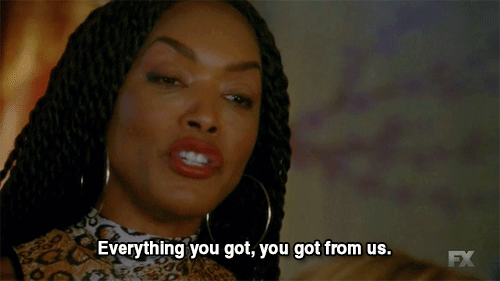
Hoodoo in America by Zora Neale Hurston (1931)
Mules and Men by Zora Neale Hurston (1936)
Tell my horse by Zora Neale Hurston (1938)
Let Nobody Turn Us Around: An African American Anthology by Manning Marable and Leith Mullings, editors (2003)
Black Magic: Religion and the African American Conjuring Tradition by Yvonne P. Chireau (2006)
African American Folk Healing by Stephanie Mitchem (2007)
Hoodoo Medicine: Gullah Herbal Remedies by Faith Mitchell (2011)
Mojo Workin': The Old African American Hoodoo System by Katrina Hazzard-Donald (2012)
Rootwork: Using the Folk Magick of Black America for Love, Money and Success by Tayannah Lee McQuillar (2012)
Talking to the Dead: Religion, Music, and Lived Memory among Gullah/Geechee Women by LeRhonda S. Manigault-Bryant (2014)
Working the Roots: Over 400 Years Of Traditional African American Healing by Michele Elizabeth Lee (2017)
Barracoon: The Story of the Last "Black Cargo" by Zora Neale Hurston (2018)
Jambalaya: The Natural Woman's Book of Personal Charms and Practical Rituals by Luisa Teish (2021)
African American Herbalism: A Practical Guide to Healing Plants and Folk Traditions by Lucretia VanDyke (2022)
youtube
youtube
youtube
youtube
These are just some suggestions but there's many many more!! This is by no means a complete list.
I recommend to avoid authors who downplay the importance of black history or straight out deny how blackness is central to hoodoo. The magic, power and ashé is in the culture and bloodline. You can't separate it from the people. I also recommend avoiding or at the very least taking with a huge grain of salt authors with ties to known appropriators and marketeers, and anyone who propagates revisionist history or rather denies historical facts and spreads harmful conspiracy theories. Sadly, that includes some black authors, particularly those who learnt from, and even praise, white appropriators undermining hoodoo and other african and african diasporic traditions. Be careful who you get your information from. Keeping things traditional means honoring real history and truth.
Let me also give you a last but very important reminder: the best teachings you'll ever get are going to come from the mouths of your own blood. Not a book or anything on the internet. They may choose to put certain people and things in your path to help you or point you in the right direction, but each lineage is different and you have to honor your own. Talk to your family members, to the Elders in your community, learn your genealogy, divine before moving forwards, talk to your dead, acknowledge your people and they'll acknowledge you and guide you to where you need to be.
May this be of service and may your ancestors and spirits bless you and yours 🕯️💀
#hoodoo#conjure#rootwork#black hoodoo authors#Youtube#hoodoo books#african american conjure#african american history#black history#black folklore#african american folklore#black magic#african american magic#witches of color#ATRs#Spotify
1K notes
·
View notes
Note
can you give any information on voodoo
I am not a practitioner of voodoo or houdu as it is a closed religion which you need to be initiated into. If you are black and would like to get into the practice of ancestral work and Louisiana voodoo, I would recommend speaking with a high priestess or mambo. As they would be better to speak on the topic than me.
That being said I do know a little about its history and cultural relevence, so i will give you a small insight as to answer your question in part.
Louisiana voodoo as it is known today derives from Haitian Hoodoo. Its origins stem from the slave trade.
The enslaved people, in order to continue practicing and communing with their ancestral spirits assimilated their pantheon, The Bondye and the Iwa into Catholic Saints. The practices are an amalgamation of different African cultures due to hundreds of years of shared struggle amongst the enslaved.
So there are many different types of practitioners and traditions depending on which region of the world you look at.
Voodoo as many western Americans know it as, was demonized by the white oppressors. Depicted as a savage religion, in which they summoned the devil and cast curses upon people and raise the dead.
But many of these demonizations stem from racist, dehumanizing tactics done in order to create fear in the Christian majority of the late 19th and early 20th century.
Voodoo is a way for practitioners to remain connected to their ancestors and bridge the gap between modern day and their ancestral time in Africa before the slave trade.
This is why it is a closed religion. It is intrinsically tied to the shared trauma and struggles of enslaved people and their descendants. And how they dealt with oppression and rose against the status quo.
I apologize I wasn't able to give you more information but as I said it is not my place to speak.
If anyone who is a practitioner, and is informed on the subject would like to add on to this post I welcome any and all input. :)
13 notes
·
View notes
Text
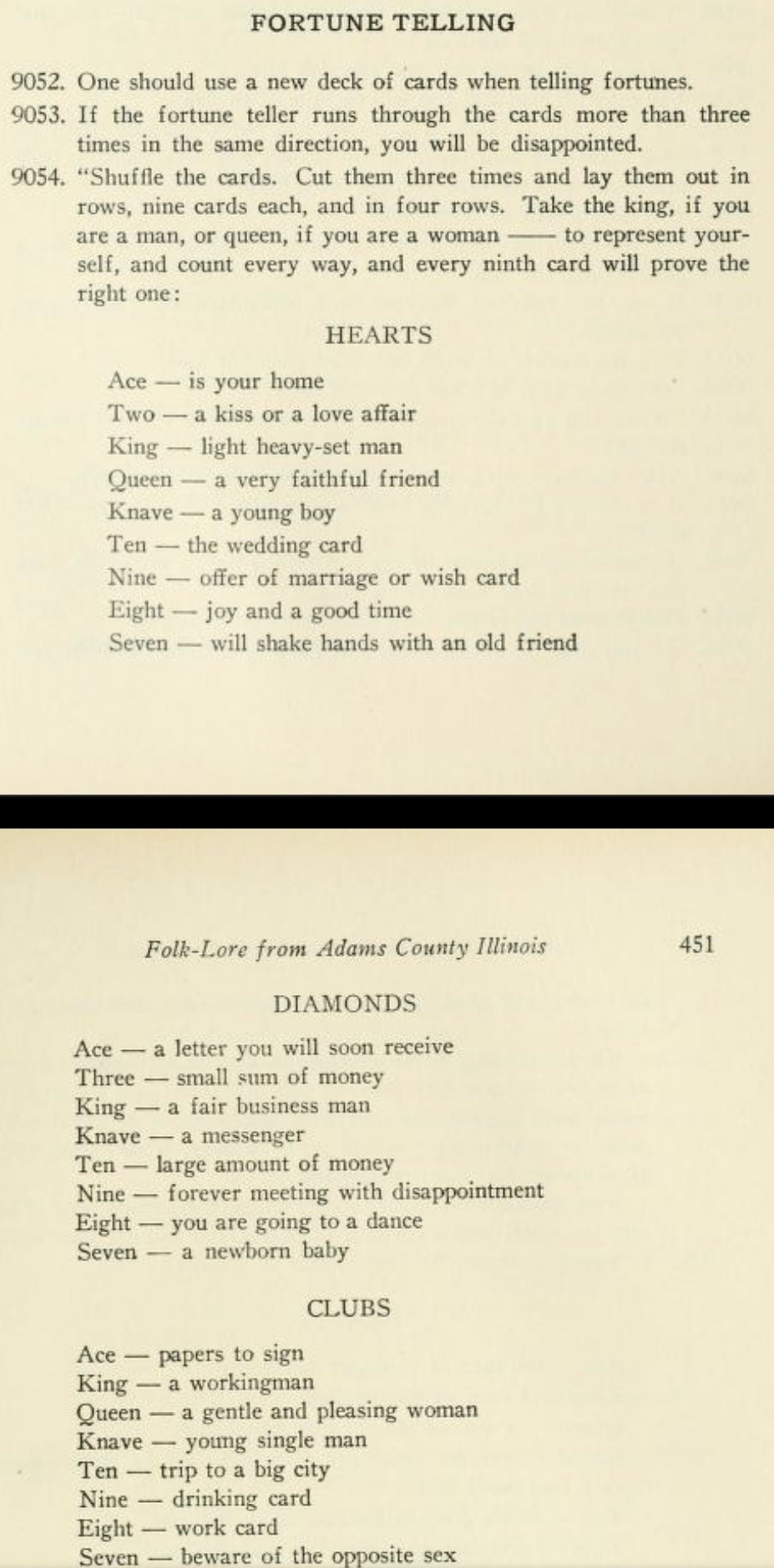
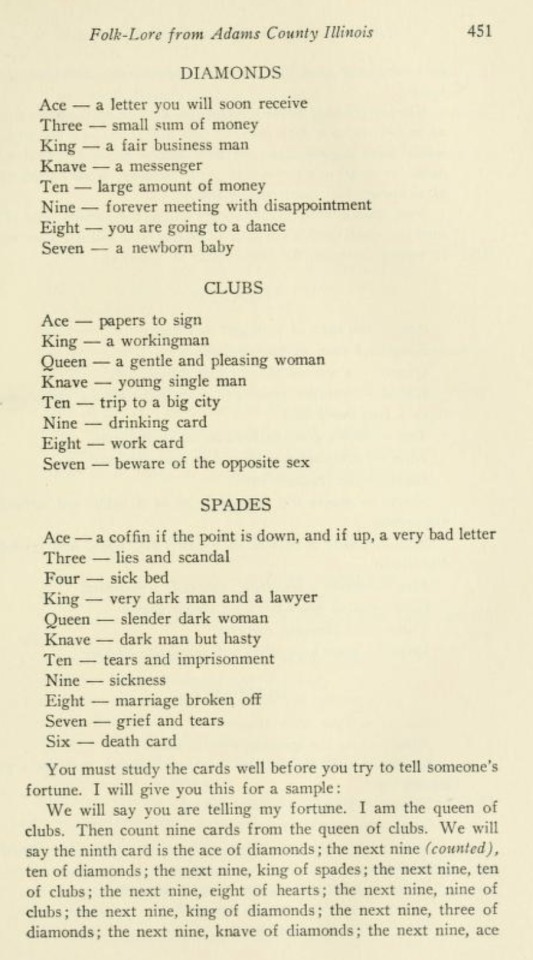
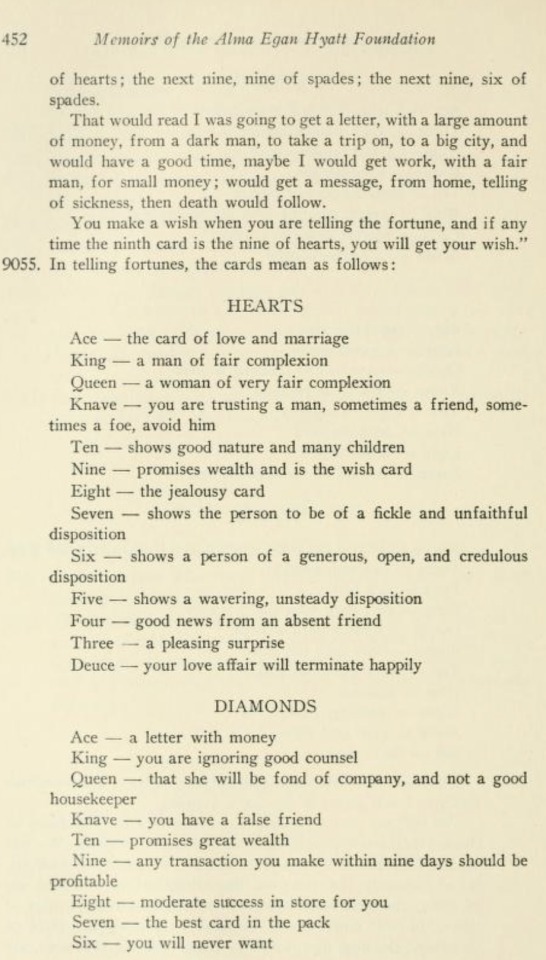
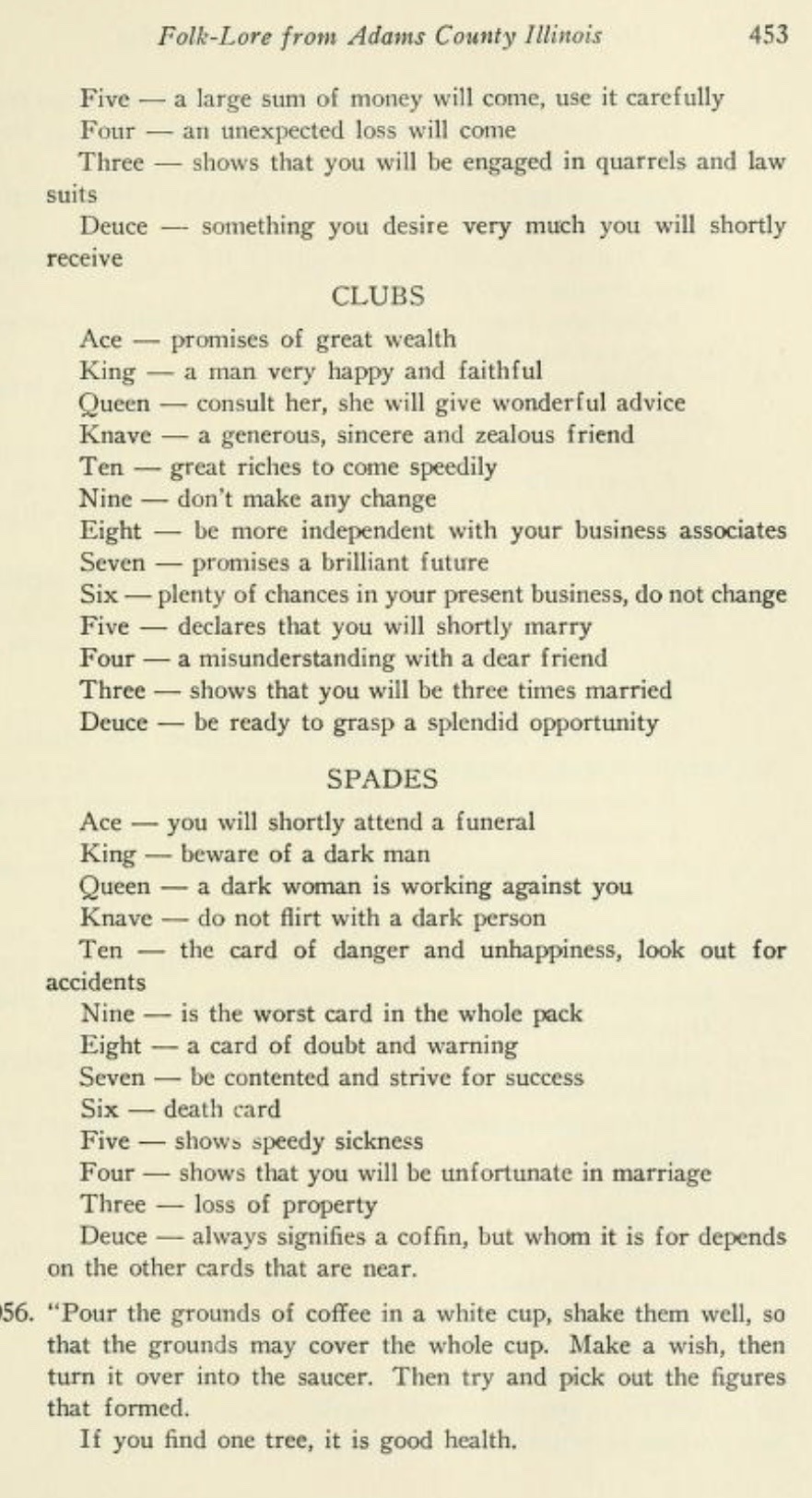
Fortune Telling with playing cards
[Folk-lore from Adams County, Illinois written by Harry Middleton Hyatt (1935)]
156 notes
·
View notes
Text
Theory without practice is dead and fruitless, and Practice without theory is impossible and harmful.
#witches#witchcraft#witch#baby witch#witch community#witches of tumblr#pagan witch#wicca#wiccapedia#wiccan#louisiana hoodoo#hoodoo ancestors#hoodoo#hoodoo witch#new orleans hoodoo#hoodoowitches#hoodoo and folk magick#folk witchcraft#witch folk#folklore#folk witch#cunning folk#catholic folk magic#cunning folk of the crooked path#catholic witch#catholic witchcraft#witchy tips#witchcraft 101:
7 notes
·
View notes
Text
New Patreon Post!!
Slavery in South Carolina and European Immigrants Shifting Views Towards Slavery
This post is by far my longest post on Patreon, is a refurbished version of a paper I did during a capstone class for my anthropology program. I would love for any of you interested in the role of non-English slave owners within the American south to give it a read. ❤️❤️❤️
#black spiritualist#hoodoo tumblr#black spiritualism#hoodoo#african american spirituality#african american culture#black spirituality#black tarot readers#rootwork tumblr#african american folklore#african ancestry#african american history#black history year#black writers#support black creatives#support black content creators#support black writers#slavery#transatlantic slave trade#american history#african americans#rootworker tumblr#rootwork#black tumblr#black witches#woc witches#witches of color#etsydigital#numerology
4 notes
·
View notes
Text
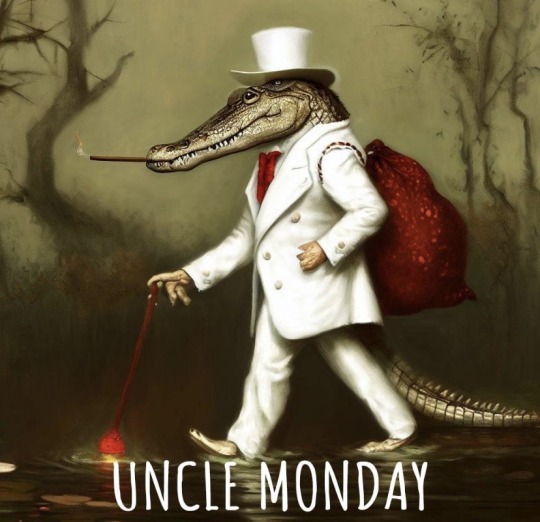
Uncle Monday is a powerful ancestral spirit that persists in southern Hoodoo lore. Uncle Monday is said to have been a medicine man of the shape-shifting variety who was brought to South Carolina with the slave trade. As the story goes, he escaped slavery and went to Florida to live among the Seminoles and the maroons, bringing his crocodile medicine with him.
A larger-than-lite figure in African American folklore, Uncle Monday is celebrated among Florida's Seminole and maroon communities. Hailing from Africa and brought to South Carolina through the harrowing transatlantic slave trade, Uncle Monday's story is one of daring escape and unwavering resilience.
Finding sanctuary among the Seminole and maroons in Florida, Uncle Monday's mystical prowess as a medicine man and hoodoo doctor shines through, with his most remarkable shapeshifting ability being the power to transform into an alligator at will! This incredible metamorphosis serves as a powerful symbol of defiance against oppression and the refusal to bow down to slavery's chains.
As the guardian of his community, Uncle Monday's legend pulses with themes of resistance, resilience, and cultural pride, inspiring generations with his indomitable spirit and unyielding courage.
references:
https://museumoffloridahistory.com/explore/collections/19th-20th-century-artifacts/art-and-ephemera/uncle-monday/
American Rootwork Association (ARA) Blog - American Rootwork Association
#african america history#african american history#african folklore#hoodoo#black history#black history month#spiritual knowledge#spiritual practices#folklore
5 notes
·
View notes
Text
Congolese food of the day: Pondu
Ingredients:
Cassava leaves
Onion
Green onion
Green pepper
Eggplant
Optional: sardine or mackarel
Recipe: crush the cassava leaves and add to a pot on low heat. Chop your veggies and add to the pot with water, still on low heat and leave until water is mostly gone

#congo#congolese mythology#congo mythology#dr congo#democratic republic of the congo#african mythology#voodoo#vodou#hoodoo#congolese#food#foodie#congolese food#african food#folklore
5 notes
·
View notes
Text
ABOUT

I've been on such a peculiar journey. I hope you can relate. I was raised in the Black Church™ and as we became more and more "evangelical" and insular the older I got I became disillusioned and left that space. Since then I guess you can say I have been floating. Looking for a home. I can't say that I have found one yet, but I have definitely become an expert in what NOT to do when you are on this type of journey. This has driven me to attempt to create this space. Space for people like me, disillusioned folks who aren't yet willing to give up on the existence of God or gods or Santa Clause. I wanted a space where questioning folk could get definitive, verifiable evidence without being manipulated by the rhetoric of marketeers or simply asked to take what resonates. With Dreamboat Theory I plan to create a central space for budding mages to study, grow and build skills before moving on to organized religions, pantheons, philosophies, practices, or programs. This is a blog about that process and my continuing journey.
#tarot#divination#dreams#lucid dreaming#dreamboat theory#atr#african american folklore#mermaid#fairies#hoodoo#rootwork#adr#african diaspora#baby witch#green witch#witchcraft
4 notes
·
View notes
Text
On January 7th, we venerate Ancestor & Hoodoo Saint, Auntie Zora Neale Hurston on her 133rd birthday (updated 2024). 🎉
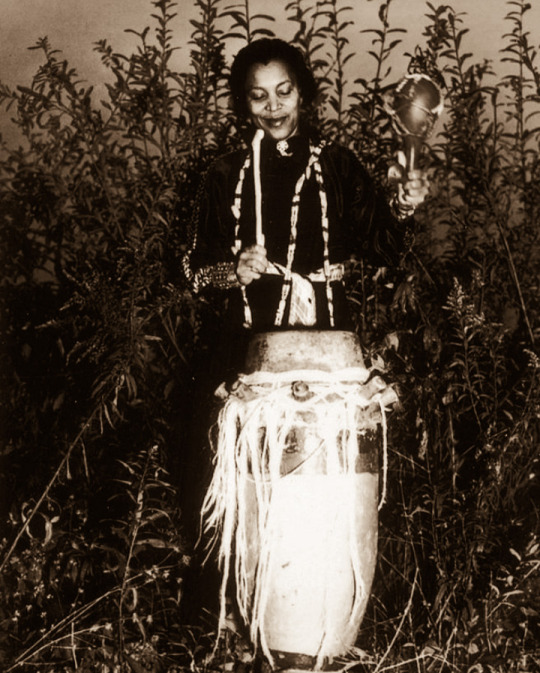
Novelist, Anthropologist, Folklorist, Scholar, Vodou initiate & Historian, Zora Neale Hurston's legacy is forever cemented in Hoodoo Culture (and beyond) as the masterful wordsmith who cast a shining light on black excellence in all everyday forms/spaces, our ATR roots, & the preservation of Black Voices during the prime of the Harlem Renaissance.
Auntie Zora was born in Notasulga, AL and raised on 5 acres of land in Eatonville, FL by her preacher-father and free-spirited mother ; in what would be the first all-Black township in the country. After the shattering loss of her mother, Zora turned up in Baltimore, MD where she presented herself as a 16 year old (10 years her junior) in order to access free public school education resources; thereby finishing school. From then on, Zora lived her life presenting herself as 10 years younger than she actually was. She'd go on to graduate from Barnard College in 1928.
She published several novellas & articles, including "Mules & Men"; a collection of Hoodoo Folklore. She entered the zenith of her career in the late 30s/40s after publishing her masterworks: "Their Eyes Were Watching God", "Tell My Horse", "Moses, Man of the Mountain", & an anthropological study on Hatian Vodou .After publishing her autobiography, "Dust Tracks on a Road, "Auntie Zora finally received the public recognition & literary respect that was long overdue. Despite her successes, and unprecedented contributions in classic literature & anthropology, Zora never received the financial contributions that her work so deserved.
Zora Neale Hurston passed away; penniless, alone, & drifting into obscurity. Friends and supporters from near and far raised $600 for her funeral service and burial. She was buried in an unmarked grave, in a segregated section, at the Garden Of Heavenly Peace Cemetery in Fort Pierce, FL. Over a decade later, in 1973 the Great Alice Walker found the unmarked grave and ordered a headstone to be placed on it; engraved with, "Genius Of The South" in Zora's honor. It remains in place today.
“Let no Negro celebrity, no matter what financial condition they might be in at death, lie in inconspicuous forgetfulness. We must assume the responsibility of their graves being known and honored.” - Zora Neale Hurston to W.E.B. Dubois
Auntie Zora wanted to be remembered & demanded that the same honor and respect be given unto her peers & others. Never forget the infectious voice that defined & defied, inspired & struck fear in many hearts of her time & after.
We pour libations & give 💐 today as we celebrate Auntie Zora for her enigmatic spirit, ancestral wisdom, labor of love for Hoodoo Folklore, & for the seeing the beauty in the dark, sometimes solemn, corners in Black Culture. Let her studies continue to inform our own. Let her spark a fire in us to reconnect to our roots & grow within our lineages.
Offering suggestions: money, music, read/share her work, libations of water, & flowers.
‼️Note: offering suggestions are just that & strictly for veneration purposes only. Never attempt to conjure up any spirit or entity without proper divination/Mediumship counsel.‼️
#hoodoo Saints#Hoodoo Saint#zora neale hurston#Hoodoo#vodou#haitian vodou#the hoodoo calendar#hoodoohistory#hoodoos#atrs#atr#hoodoo culture#bvm#Hoodoo Folklore#Black authors#Black writers#own voices#Black Power
691 notes
·
View notes
Text
You do not understand... 👀
I mean... If you do a cleansing, put some eggs in each corner, rosemary in the door and a sprig of mint under your bed, and that haters suddenly stop sleeping for too many nights... And they are back to you begging and crying for help... Hey, it's just a coincidence, right? Because... we believe in coincidences and stuff... right? 😏💅
Cause we never would cause any damage to anyone by will, we are here all peace and love 🤞🏼
As our extremely patient abuelas teach us to be 😏
#wicca#witchcraft#magick#magic#witches#pagan#wiccan#brujeria#paganism#brujas#folk magic#folk witchcraft#folklore#folk Witch#hoodoo#voodoo#lucumi#green witch#green witches#green witchcraft#green magic#traditional witchcraft#herbal magick#herbal magic#herbal witch#witchy things#witchy stuff#spells
5 notes
·
View notes
Text
The root of the common Male Fern (filix mas) was an important ingredient in the love-philtres of former days. An old Gaelic bard sings:
‘Twas the maiden’s matchless beauty
That drew my heart anigh
Not the Fern-root potion
But the glance of her blue eye
In olden times the young scroll-like fronds of this fern were called Lucky Hands, or St. John’s Hands, and were believed to protect the possessor from sorcery, witches’ spells, and the Evil Eye. In Germany, the male fern was called Johanniswurtzel; and on both the continent, and in England, it was the custom, on Midsummer Eve, to gather this Fern, which was sold to the credulous, who wore it about their persons, and mingled it with the water drunk by their cows, as a protection against all evil spirits, and to ensure good luck.
- The Night-Seeding Fern
2 notes
·
View notes
Text

Adam and Roxanne
this whole aesthetic 😍
#central flow#central flow roxanne#central flow adam#fae#fae aesthetic#folk magic#hoodoo#black alternative#witchblr#green witch#kitchen witch#alt black girl#indigenous people#goth black girls#black fae#southern gothic#dark academia#folklore#wanderer
0 notes
Text
New Patreon Post ❤️
This time I decided to write about dream interpretation within Hoodoo. This one is open to everyone ❤️ Let me know what yall think ❤️
#black spiritualist#hoodoo tumblr#black spiritualism#hoodoo#african american spirituality#african american culture#black spirituality#black tarot readers#rootwork tumblr#rootworker tumblr#rootwork#black tumblr#black witches#woc witches#support black content creators#witches of color#african american folklore#african american#african american folktales#african american history
3 notes
·
View notes
Text
Congolese myth of the day:
Kalala and the Rainbow King (there are many versions); Kalala Ilunga was the founder of the Luba tribe. He spent his early life in the court if the rainbow king, Nkongolo. One day, a prince from the east Mbidi Kiluwe, came to the land of Nkongolo, who did his best to please his guest. Nkongolo gave Mbidi his twin sister, Mabela and Bulanda, who both became pregnant soon after. Mabela had twins, a boy and a girl and Bulanda had a son, Kalala who Nkongolo claimed and raised as his own son while Mbidi returned home. Kalala became the country’s best runner and dancer. Because of this, the rainbow king resented him and plotted to have him killed. He hid a pit of sharpened stakes on the dancing grounds and invited Kalala to a dancing contest. Warned of the danger by his drummer, Kalala fled across the Lualaba river to his father, as Nkongolo did everything to lure him back. First he sent men across the river to get the fugitive prince, but the waters rose up and drowned them before they could reach the shore. Then the king tried to build a stone bridge across the river but the stone resisted. As the rainbow king built a tower to be able to see his enemy, Kalala unlisted his father’s help and together they prepared an army. The rainbow king fled with his sisters to Kaii Mountain, in the west, but his sisters betrayed him. Kalala’s men cut of Nkongolo’s head. It is said his spirit lives on as a serpent and sometimes appears as a rainbow
Kalala Ilunga était le fondateur de la tribe Luba. Il a passé sa jeunesse à la cour du roi arc-en-ciel, Nkongolo. Un jour, un prince de l'est Mbidi Kiluwe, est venu au pays de Nkongolo, qui a fait son meilleur pour faire plaisir à son hôte. Nkongolo a donné Mbidi sa sœur jumelle, Mabela et Bulanda, qui sont tombées enceintes peu de temps après. Mabela avait des jumeaux, un garçon et une fille et Bulanda avait un fils, Kalala, que Nkongolo a élevé comme son propre fils tandis que Mbidi rentrait chez lui. Kalala est devenu le meilleur coureur et danseur du pays. À cause de ça, le roi lui a comploté pour le faire tuer. Il a caché une fosse de piquets aiguisés sur le terrain de danse et a invité Kalala à un concours de danse. Averti du danger par son batteur, Kalala s'enfuit de l'autre côté de la rivière Lualaba vers son père, alors que Nkongolo fait tout pour l'attirer. Il a envoyer des hommes de pour chercher le prince fugitif, mais les eaux montèrent et les noyèrent avant qu'ils ne puissent atteindre le rivage. Ensuite, le roi a essayé de construire un pont de pierre sur la rivière, mais la pierre a résisté. Alors que le roi construisait une tour pour voir son ennemi, Kalala a retiré l'aide de son père et, ensemble, ils ont préparé une armée. Nkongolo s'enfuit avec ses sœurs vers la montagne Kaii, à l'ouest, mais ses sœurs le trahirent. Les hommes de Kalala ont coupé la tête de Nkongolo. On dit que son esprit vit comme un serpent et parfois comme un arc-en-ciel
#dr congo#congolese#congo#democratic republic of the congo#congo mythology#folklore#african mythology#stories#hoodoo#voodoo#vodou#mythology#myth
0 notes
Text
The Ultimate Grimoire Guide
So! I have been seeing a ton of grimoire ideas and thought I’d stuff them all together. A lot of ideas are from @manifestationsofasort, @banebite, and @pigeonflavouredcake. Check them out! They have a ton of cool stuff there.
What Do I Use For My Grimoire?
You can use anything for a grimoire! For a physical one, journals, binders, and notebooks are good. For digital ones, Notion, Tumblr, Docs, and even just your file folder are great.
Introduction
A Book Blessing
Table of Contents
About Me
Your Current Path
Your Personal Beliefs
Your Spiritual Journey
Superstitions
Past lives
Favorite Herbs/Crystals/Animals/Etc.
Natal Chart
Craft Name
How You Entered The Craft
Astrology Signs
Birthday Correspondences (birth tarot card, birth stone, etc.)
Goals
Safety
Fire Safety
What Not to Burn
Toxic Plants & Oils (to humans, plants, animals)
Crystals That Shouldn’t Be Put… (in sun, in water, etc.)
Things That Shouldn’t Be In Nature (glass, salt, etc.)
Potion Safety
How to Incorporate Blood in Spells
Smoke Safety
Wound Care
Biohazards
Core Concepts
Intention & How It Works
Directing Energy
Protection
Banishing
Cleansing
Binding
Charging
Shielding
Grounding
Centering
Visualization
Consecration/Blessing
Warding
Enchanting
Manifestation
Meditation
What Makes A Spell Work
Basic Spell Structure
What Not To Do In Spells
Disposing Spell Ingredients
Revitalizing Long Term Spells
How To Cast Spells
What To Put In Spells
Spell Mediums (jars, spoken, candle, sigils)
Spell Timing
Potion Bases
Differentiating Between Magick and Mundane
Common Terms
Common Symbols
Intuition
Elements
Basic Alchemy and Symbols
Ways To Break Spells
Laws and Philosophies
Correspondences
Herbs & Spices
Crystals & Rocks
Colors
Liquids & Drinks
Metals
Numbers
Tarot Cards
Elements
Trees & Woods
Flowers
Days
Months
Seasons
Moon Phases
Zodiacs
Planets
Incense
Teas
Essential Oils
Directions
Animals
Symbology
Bone Correspondences
Different Types of Water
Common Plants
Entities
Deities You Worship
Pantheons
Pantheons & Deities Closed to You
Common Offerings
Epithets
Mythos
Family
Worship vs Work
Prayers & Prayer Template
Altars
Deity Comms
Devotional Acts
Angels
Demons
Ancestors
Spirit Guides
Fae
Familiars
House, Animal, Plant, Etc. Spirits
Folklore Entities
Spirit Etiquette
Graveyard Etiquette
Boundaries
Communication Guide & Etiquette
Spirit Work Safety Guide
How Entities Appear To You
Circle Casting
Common Offerings
Altars
Servitors
Mythological Creatures (dragons, gorgons, etc.)
Utility Pages
Gazing Pages
Sigil Charging Station
Altar Pages
Intent Pages
Getaway Pages
Vision Boards
Dream Pages
Binding Page
Pendulum Board
Crystal Grid
Throwing Bones Page
Divination Pages
Mirror Gazing Page
Invocation Pages
Affirmation/Manifestation Pages
Spirit Board Page
Other Practices
Practices That Are Closed to You (Voodoo, Hoodoo, Santeria, Brujeria, Shamanism, Native Practices)
Wicca and Wiccan Paths
Satanism, Both Theistic and Non-Theistic
Deity Work
Religious Paths (Hellenism, Christianity, Kemeticism, etc.)
Animism
Types of Magic/Spells
Pop Culture Paganism/Magic
Tech Magic
Chaos Magic
Green Magic
Lunar Magic
Solar Magic
Sea Magic
Kitchen Magic
Ceremonial Magic
Hedge Magic
Death Magic
Gray Magic
Eclectic Magic
Elemental Magic
Fae Magic
Spirit Magic
Candle Magic
Crystal Magic
Herbalism
Glamours
Hexes
Jinxes
Curses
Weather Magic
Astral Magic
Shadow Work
Energy Work
Sigils
Art Magic
Knot Magic
Music Magic
Blood Magic
Bath Magic
Affirmations
Divination
Tarot Cards
Oracle Cards
Playing Cards
Card Spreads
Pendulum
Numerology
Scrying
Palmistry
Tasseography
Runes
Shufflemancy
Dice
Bibliomancy
Carromancy
Pyromancy
Psychic Abilities
Astrology
Auras
Lenormand
Sacred Geometry
Angel Numbers
Ornithomancy
Aeromancy
Aleuromancy
Axinomancy
Belomancy
Hydromancy
Lecanomancy
Necromancy
Oneiromancy
Onomancy
Oomancy
Phyllomancy
Psephomancy
Rhabdomancy
Xylomancy
Tools
Crystal grid
Candle grid
Charms
Talismans
Amulets
Taglocks
Wand
Broom
Athame
Boline
Cingulum
Stang
Bells
Drums
Staffs
Chalices
Cauldrons
Witches Ladder
Poppets
Holidays
Yule
Imbolc
Ostara
Beltane
Litha
Lammas
Mabon
Samhain
Esbats
Deity Specific Holidays
Religious Holidays (Christmas, Easter, Dionysia, etc.)
Celestial Events
Altars
Basics of Altars
Travel Altars
Deity Altars
Spirit Altars
Familiar Altars
Ancestor Altars
Self Altars
Working Altars
Self-Care
Burnout Prevention
Aromatherapy
Stress Management
Coping Mechanisms
Theories & History
Witchcraft history
Paganism
New Age Spirituality
Cultural Appropriation
Thelema
Conspiracy Theories
Cults
Satanic Panic
KJV
Witches in History
Cats in History
Transphobia in Witchcraft Circles
Queerness in Witchcraft Circles
Other
Recipes
How to Get Herbs
Foraging
Drying Herbs and Flowers
Chakras
Reiki
Witches Alphabet
Runic Alphabet
Guide to Gardening
Your Witch Tips
Resources
Other Tips
List of Spells
Cryptids and Their Lore
What is a Liminal Space?
#witch#witchblr#baby witch#witchcraft#witches#kitchen witch#witchcore#witch aesthetic#witchery#witches of tumblr#spoonie witch#beginner witch#witch community#moon witch#green witch#pagan witch#witchy#grimoire#bos#book of shadows#grimoire ideas#book of shadows ideas#bos ideas
5K notes
·
View notes